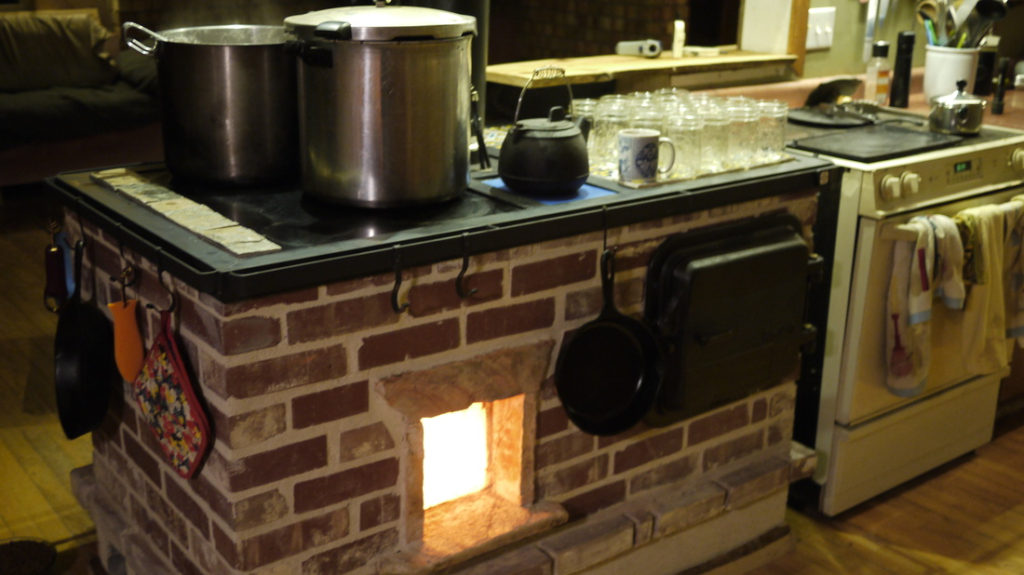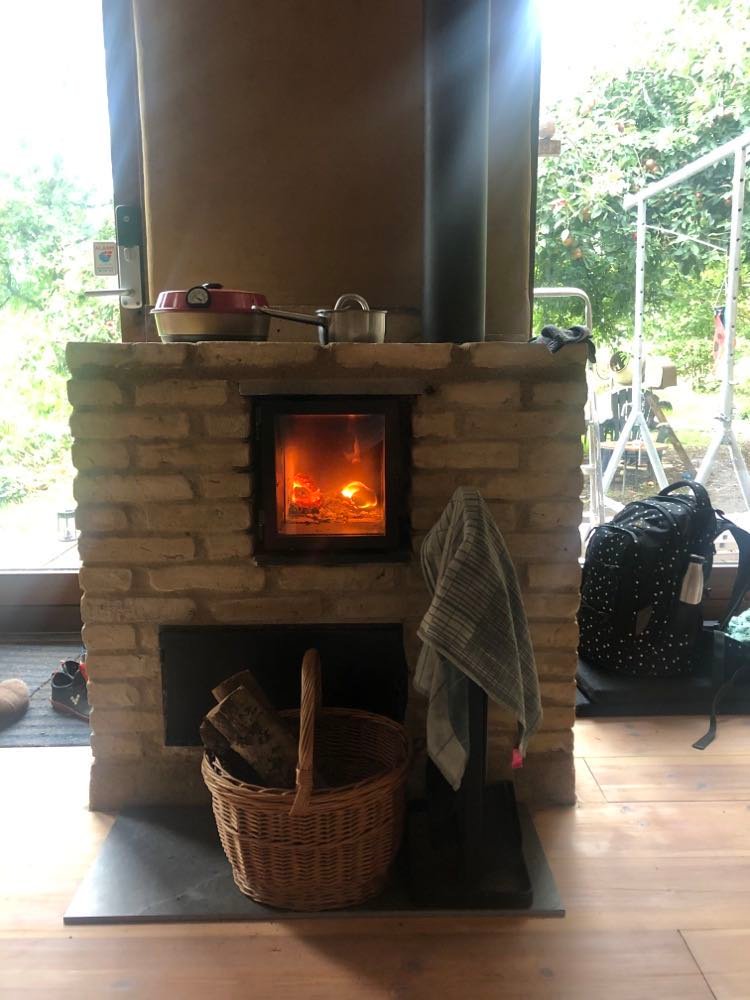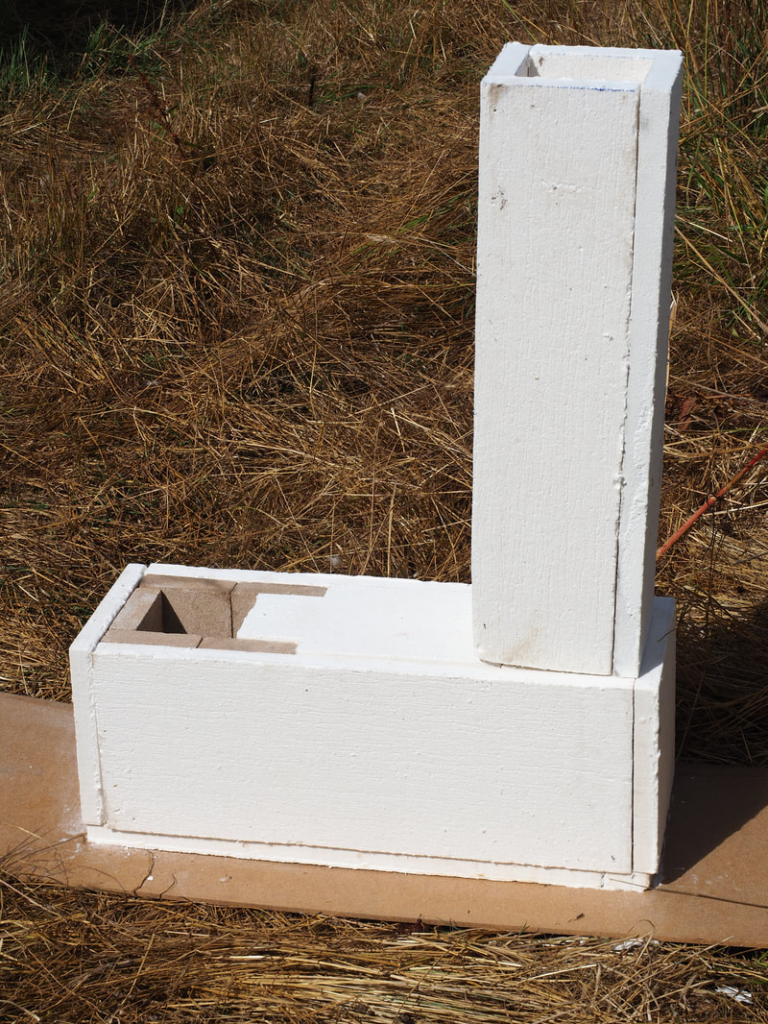Walker Pre-Port Secondary Air
The Walker Pre-Port secondary air configuration is a modification to Peter van den Berg’s Batch Box Rocket combustion core design. His design can be found here, and a development thread here.
This modification is my design, refined in my home system over the winter of ’14-’15 to fit my needs. It is not necessarily a more efficient burner than Peter’s original design, but it suits my needs and offers exceptional stability and control.

I documented the development in a thread you can find here. I’ve settled into the following design parameters, although depending on many factors each system will require fine tuning for best performance.
Sizing shown is for a 6″ system:
Primary Inlet size 2 sq. in.
Secondary Inlet size 2.81 sq. in.
For the secondary delivery inlet tube I am using rectangular tubing 2.25″ x 1.25″ I.D., with a wall thickness of 1/8″. The delivery tube is recessed in a slot in the firebox floor, exposed to the coals, extending to about 1.5″ away from the entrance to the port into the riser. (See link to Peter’s firebox design above).
A section of 2″ I.D. tubing is attached vertically to the end of the square tubing, and should be approximately 9″ long, or as tall as the port. The top should be open, and a slot 3/8″-1/2″ let into the tubing on the side facing the port.

In the early iteration pictured above the lower tube has some outlets. You can ignore those, that part of the tube should be recessed into the firebox floor. The rest of the tube is generally what I have settled on. I now run the slot all the way through the top for simplicity’s sake.
Door build is important in this configuration. It must be airtight with the exception of the design parameters regarding air, and where the air enters matters quite a bit. I have found it’s very nice to have a much larger opening than primary down low for start up. Whether it’s a small start up door, or just cracking the main door, it helps to have extra air moving to get things going. Once the secondary combustion has ignited and is stable, it can run on the designed primary/secondary configuration as long as draft is sufficient. Primary air inlet should be located with the opening low enough in the firebox to encourage the fuel to pyrolize, but not so low as to race through the ash bed picking up particulate or causing a fuel rich situation by over-pyrolizing the fuel. Where this is will depend a lot on your fuel, but generally I’ve found an adjustable primary opening of 2 sq. in. centered side to side, and about one third of the way up the firebox from the floor, works well in most cases. If your fuel is very dry or very small you may want to raise that a bit.

So, what’s the deal with it? Well, for one, it smooths out the heat delivery cycle into a longer, more moderate burn rate and heat delivery. If you have an all masonry heater, I think Peter’s design of the hottest fire possible for the shortest time is probably the path to the greatest efficiency, but in a heater where there is a radiant/convective component from bare metal like a wood stove, or rocket mass heater, the longer heat delivery per load translates to a more even comfortable heat cycle in the house with less tending.
The chart to the left shows a typical burn, using cord wood, on an average night. You can see that for almost an hour the Carbon Monoxide was down below 10ppm, while efficiency stayed in the high 80% range. Compared to a typical rocket stove type burn this represents a “sweet spot” in the burn cycle that is almost three times as long. If you have a metal radiator in the system, that’s three times as long it is running at a high temperature off of one load.
Finally, and I think most importantly, this configuration slows air through the firebox and ash bed significantly over either the original J-tube Rocket or Peter’s Batch design. In my opinion this air configuration leads to far lower emissions and a significant reduction in PM 2.5 emissions specifically. I hope to be able to bring a heater in for certified testing before too long to verify this, but for now there are some good indications that this design will pass current and upcoming EPA standards.
I’m looking for ways to share information with all interested and move this technology forward so we can stop living next to smokey chimneys and working too hard for our heat and cooking needs! I would love to engage in dialog on what information would help, and how best to present it, so please give me feedback. I intend to start to create more detailed plan sets of these innovations, letting me know it’s appreciated and what information you’d like is incredibly motivating.

Here’s my latest door. It’s not pretty, but it has taught me a lot. Generally I would say I’m satisfied with this configuration, although I could have a larger start up door or perhaps a half door lower section that opened.

Secondary Air Update 2/23

The sizing and configuration described above has proven to be extremely effective at delivering a clean burn and high efficiency.
I no longer recommend the slit on the rear side of the vertical. It leads to deterioration and does not add enough benefit to be worth the extra work and shorter lifespan.
The issue of vertical tube deterioration has been solved to my satisfaction by the use of Rolled Alloys RA330 high temperature alloy pipe in that location. This material easily handles the temperatures inside the firebox and will last indefinitely in service.
Walker Riser-less Combustion Core


I’m so excited and pleased to announce my new core design, the Walker Riser-less combustion core!
This core is the result of my work with reducing firebox velocity and stabilizing the burn cycle of a Batch Rocket as detailed in the Secondary Air discussion above.
The inspiration to finalize this design came when Lasse Holmes and Max Edleson invited me to come collaborate with them on the Cabin Stove 2.0. While you are there make sure to check out the Firespeaking site, home of Max and his wife Eva’s amazing work in fire and natural materials. Incredibly inspiring work by wonderful people….
I returned home from my time with them inspired to focus my efforts on a core that fit the cook stove format yet fit my design ideals of complete combustion in a variety of conditions combined with stable, useable heat delivery and a burn cycle that fit the function. Since it was intended to be a cook stove, stability and control over both length of burn and temperature output were important features to me, as was speed to come up to cooking temperature.
Here’s the basic layout for the core so you can play with it yourself. I intend to have more details available for download in the near future.
I used low density insulated fire brick for this build, because it’s what I had on hand. From a combustion performance stand point I would choose this material as my brick of choice, but they will be damaged easily in the firebox. You may choose to build the firebox portion out of dense firebrick, or build it as shown and cut dense firebrick “splits” to fit inside as a liner.



Base Layer
Channel for Walker Secondary Air. Long, even cooking temps and extremely low CO throughout the cycle. Typically, rocket-type combustion configurations deliver max BTUs over minimum time, which is excellent for heating mass but for cooking this combustion design offers a great burn profile.
First Layer
This is how I laid it out for a window in an island type layout. You could make that back wall all brick for a window delete version.


Second Layer
Third Layer
Pretty straightforward from here on out. These make the roof of the burn areas and the floor of the cook top chamber. This layout forms a 22″ cube, and top routing is configurable depending on cook top/extraction strategies.


Fourth Layer
Here you can see my cook top design. Out of the riser, over the firebox, and back past the riser side into the remainder of the stove body.


So there it is, my Walker Riser-less core. I’ve built two complete cook stoves with this core now, as well as a few test beds, and am satisfied that I have achieved my design goals as it stands. I do hope to continue to tweak it with input from all of you, but I think it’s ready to publish. I have not run a whole lot of tests on it as of yet, but each time I have it has performed beyond my expectations.
It’s important to have the door air tight and the air inlets correctly sized and configured, so check out the Walker Pre-Port secondary air section above for details and measurements.



Walker super-hot ceramic fiber cores

Walker Super-Hot Shippable Rocket Stove, Rocket Mass Heater, or Masonry Cook Stove Cores are modular refractory cores that you can cut yourself using easy to follow plans. Representing not only a new approach to wood heat, but a new approach to delivering you the information you need to build the highest performance rocket stoves and mass heaters.
I have been seeking a way to share this wonderful technology with a wider audience, and have been stymied for years by various barriers. After years of testing this concept, refining the design, and working through the many roadblocks, the perfect rocket core is finally available, and can be easily built by anyone.


The Walker Super-Hot J represents the pinnacle of performance in J rockets. This design has been in development since early 2013. Time tested and proven a winner both in efficiency and durability, the Super-Hot J is constructed of highly insulated ceramic fiber board assembled simply into an inner core for your rocket stove or mass heater project. Using the non-flammable material of your choice, brick, cob, stone, backerboard and tile, aluminum, steel, etc., the core is simply surrounded and contained, creating a stove of ultimate performance and durability. Construction is simple, no special skills or tools needed. The board can be cut easily with a knife or handsaw. The firebox is lined with durable, replaceable, customer-supplied fire brick “splits”. Together these components give you the tools to create a stove or heater of incredible durability and performance with a minimum of hardware, fuss, or uncertainty.
The Half Barrel System for Rocket Mass Heaters
Developed around 2012, the half barrel system is a simple method of building hollow structures out of cob using half oil drums for arch forms. This is a fantastic method for bench construction, bell tops, arches, or any where curved support is desired in a cob structure.



Copyright © 2023 Walker Stoves®. All rights reserved.